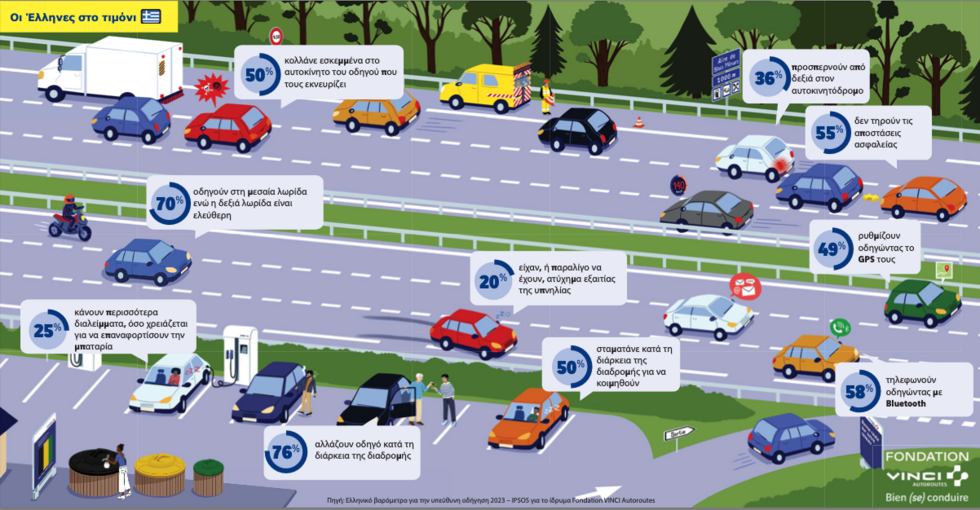The improvement of road safety in Greece, which will lead to a reduction in road crashes, for the time being remains a virtual reality. It exists in the Government’s commitments, but it is non-existent in everyday citizens’ life. A LiFO survey on the scourge of road crashes.
Much has been written and said about road safety in Greece and the lives lost on the road. On road safety improvements and the “holistic countermeasures” that need to be made, there are many opinions, Government commitments, plans and many committees appointed to address this problem. But few steps forward have been taken. The measures that should have been taken and announced several times remain stalled and unimplemented.
There is not a single month in the past year that the Greek Police and the Greek Statistical Institute‘s bulletin did not announce hundreds of road crashes, with dozens of fatalities and more than a hundred times as many seriously injured. Many of these injured persons will live the rest of their lives with a minor or major degree of disability. But could the “randomness” of a road traffic crash be prevented?
Could our fellow human beings, including thousands of young people, have been saved? The answer from road safety experts is that many of them could have been saved if a comprehensive set of actions had been implemented, including enforcement, education, awareness-raising, infrastructure improvement and institutional changes, which do not exist today and are holding the country back in this sensitive area.
One of the disappointing records is that Greece has one of the highest fatality rates (56%) in road crashes occurring in residential areas compared to the European average which stands at 36%.
This is properly demonstrated in the National Road Safety Strategic Plan for the decade 2021-2030 by the Ministry of Infrastructure and Transportation. This Plan was prepared with the active scientific support of the National Technical University of Athens. It is a complete and comprehensive Plan, but it is not being implemented.
The National Road Safety Strategic Plan was presented in February 2021 by the Prime Minister Kyriakos Mitsotakis and signaled the “practical demonstration that the improvement of road safety is a priority for the government.”
All measures, actions and regulations prioritized by the Strategic Plan, which has been in progress for three years, have not been implemented yet. Currently, the country has an incomplete Road Traffic Code since 2018, which has not been revised, a weak fine collection system, and a depleted Traffic Police that cannot effectively patrol the roads and lacks digital means of violation detection and recording. This situation encourages irresponsible and aggressive driving.
First cause of road crashes in urban areas in a city without enforcement
One of the disappointing records in Greece is that it has one of the highest fatality rates (56%) in traffic crashes occurring in urban areas compared to the European average, which stands at 36%. Since most fatal crashes happen within cities and urban networks, where most speeding violations occur with 44.2% driving over the permitted speed limits, the immediate priorities of this Plan should be increased enforcement by the Traffic Police. In the National Road Safety Strategic Plan, it is highlighted that “the intensification of supervision by the Traffic Police is proven, both in Greece and internationally, as the paramount measure that can lead to the improvement of driver behaviour and the reduction of road crashes”, which is something that has not been implemented yet.
The most important aspect that has to be done is to monitor speeding over the limits, especially in cities and at the interurban network, where we have the highest number of violations. However, sparse enforcement does not manage to be perceived by the drivers, resulting in no change in driver behaviour, which is why all these crashes are happening.
Policing is linked to a significant institutional priority that has been left behind, there is a need to have proper organization in the infringements management system, because few infringements are recorded and fines are not sent to the drivers. There is no infrastructure for mass sending of fines and people realize this, which is why they freely break the law.
The two absolute priorities are to focus on speeding and the use of helmets by motorcyclists. We are in the worst position in Europe, in Greece we have a notably high percentage of moped and motorcycle fatality rates, which is 36%, compared to Europe where the average is 18%. Therefore, we need to focus on helmet use. The percentage of drivers wearing helmets is 80% in Greece, while in Europe, is 97%. With regards to passengers, this percentage is equal to 65% and 95% in Greece and EU, respectively. The other aspect that we need to focus on is speeding, the primary cause of road crashes. In this way, we can significantly reduce road crashes and fatalities.
The five killers on the road
The horrific statistics of road crashes and dangerous driving behaviour have no end. According to the NTUA team that developed the National Road Safety Strategic Plan for Greece, the most critical factors causing road crashes in the country are high speed driving, heavy traffic and dangerous driving by motorcyclists, low rates of seat belt and helmet use, mobile phone use and driving under the influence of alcohol. Even being at the forefront in reducing road crashes during the 2010-2020 decade by 54%, the position of Greece in the European ranking have not been improved.
During the period 2017-2019, Greece had a high fatality rate (36%) in road crashes involving motorcycles and mopeds, twice as high as in the EU. Our country recorded one of the highest fatality rates (54%) in road crashes within urban areas (compared to the EU average 39%), mainly due to motorcycle crashes. In addition, 79% of drivers killed in passenger cars were not wearing seat belts or seat belt use was not recorded. Similarly, 69% of motorcyclists and moped riders killed were not wearing helmets or helmet use was not recorded. The rates of passengers not wearing seat belts or helmets, or whose use was not recorded in passenger cars, motorcycles, and mopeds, were even higher compared to those of killed drivers.
Furthermore, 55% of fatalities in passenger cars and 43% of motorcycle-related fatalities resulted from a collision with another involved vehicle, indicating that crashes occurred due to the high speed at which the vehicles were moving. The counts taken in 15 cities in Greece in the spring of 2022 by the National Technical University of Athens (NTUA), which recorded performance in key road safety indicators (speed, mobile phone use, seat belt and helmet use), do not allow for optimism for responsible driving behaviour in Greece.
The urban network has the lowest percentage of vehicles travelling within the speed limit (55.8%) compared to highways (76.9%) and the interurban network (84%). The interurban network includes rural roads outside residential areas and the whole country’s network except for major highways, where the speed limit is 90 km/h. The mobile phone use rate is higher on the urban network (8.3%) compared to highways (6.9%) and interurban roads (5.9%).
Lastly, seat belt use by rear-seat passengers is much lower (55.8%) compared to front-seat passengers (65%). In the urban network, 63.9% of front-seat passengers and 54.6% of rear-seat passengers wear a seat belt. For the interurban network, the corresponding percentages are 65.1% and 56.2%. On highways, the percentages increase: 77.1% of front-seat passengers and 65.5% of rear-seat passengers wear seat belts. The helmet use rate is 75.5% and 60.5% for drivers and passengers, respectively. The motorcycle passengers’ helmet use is much lower compared to riders, both on highways and interurban roads.
Interview to Lifo magazine in January 2024

